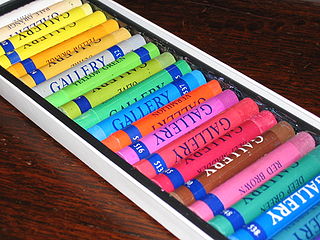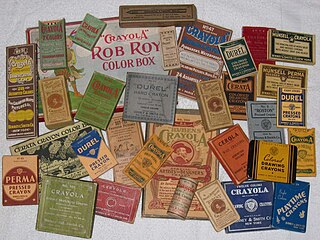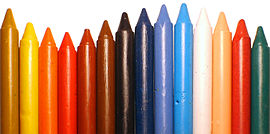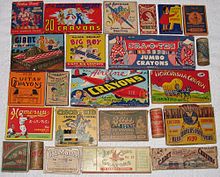
A pastel is an art medium in a variety of forms including a stick, a square, a pebble, or a pan of color, though other forms are possible; they consist of powdered pigment and a binder. The pigments used in pastels are similar to those used to produce some other colored visual arts media, such as oil paints; the binder is of a neutral hue and low saturation. The color effect of pastels is closer to the natural dry pigments than that of any other process. Pastels have been used by artists since the Renaissance, and gained considerable popularity in the 18th century, when a number of notable artists made pastel their primary medium.

Crayola LLC, formerly the Binney & Smith Company, is an American manufacturing company specializing in art supplies. It is known for its brand Crayola and best known for its crayons. The company is headquartered in Forks Township, Pennsylvania in the Lehigh Valley region of the state. Since 1984, Crayola has been a wholly owned subsidiary of Hallmark Cards.

Conté, also known as Conté sticks or Conté crayons, are a drawing medium composed of compressed powdered graphite or charcoal mixed with a clay base, square in cross-section. They were invented in 1795 by Nicolas-Jacques Conté, who created the combination of clay and graphite in response to the shortage of graphite caused by the Napoleonic Wars. Conté crayons had the advantage of being cost-effective to produce, and easy to manufacture in controlled grades of hardness.

An oil pastel is a painting and drawing medium formed into a stick which consists of pigment mixed with a binder mixture of non-drying oil and wax. They differ from other pastel sticks which are made with a gum or methyl cellulose binder, and from wax crayons which are made without oil. The surface of an oil pastel painting is less powdery than one made from gum pastels, but more difficult to protect with a fixative. Oil pastels are bold and bright. They can be blended easily but they can break easily too.
A writing implement or writing instrument is an object used to produce writing. Writing consists of different figures, lines, and or forms. Most of these items can be also used for other functions such as painting, drawing and technical drawing, but writing instruments generally have the ordinary requirement to create a smooth, controllable line.
Prismacolor is a brand of professional visual arts supplies originated in 1938 by the Eagle Pencil Company, and currently manufactured by Newell Brands. Prismacolor products include, colored and graphite pencils, soft pastels, erasers, pencil sharpeners, and cases. In past years, Prismacolor also produced watercolor paintings and charcoals.

Edwin Binney was an American entrepreneur and inventor, who created the first dustless white chalk, and along with his cousin C. Harold Smith, was the founder of handicrafts company "Binney and Smith", which marketed his invention of the Crayola crayon. The Binney family lived in Old Greenwich, Connecticut, as well as Fort Pierce, Florida.
Sanguine or red chalk is chalk of a reddish-brown colour, so called because it resembles the colour of dried blood. It has been popular for centuries for drawing. The word comes via French from the Italian sanguigna and originally from the Latin "sanguis".

Liquitex is a US company that supplies art materials, focusing exclusively on the development, manufacture and distribution of acrylic paints. Founded by Henry Levison as "Permanent Pigments" in 1955, the company created the first water-based acrylic gesso. That same year, Levison decided to reorganize the company under the name "Liquitex". In 1956, the company starting selling water-based "Soft Body" acrylic paints. In 1963, "Heavy Body" paints were available with a thicker consistency. The company offers the largest number of acrylic paint products in the world.
Caran d'Ache is a Swiss manufacturing company of art materials and writing instruments. The company, established in 1915, produces a wide range of products including colored pencils, graphite pencils, pastels, fountain pens, ballpoint pens, mechanical pencils, markers, gouache paints, and ink cartridges.
The following is a partial timeline of Crayola's history. It covers the Crayola brand of marking utensils, as well as the history of Binney & Smith, the company that created the brand and is currently a subsidiary of Hallmark Cards known as Crayola LLC.
Classmate is an Indian brand of student stationery products. ITC Limited launched its Classmate brand in 2003 with the notebooks category. Subsequently, Classmate added pens, pencils, mechanical pencils and geometry boxes to its portfolio. It uses eco-friendly and elemental chlorine-free paper.
The following outline is provided as an overview of and typical guide to drawing and drawings:

Royal Talens is a Dutch company located in Apeldoorn that specializes in art materials. The company produces and markets its own products, apart from commercializing other licensed brands such as Van Gogh, Rembrandt, Bruynzeel. Products commercialised include acrylic paints, oil paints, watercolor paintings, brushes, markers, inks, pastels, pencils, pens, gouache, canvas, papers.

A colored pencil, coloured pencil, pencil crayon, map pencil, or coloured/colouring lead is an art medium constructed of a narrow, pigmented core encased in a wooden cylindrical case. Unlike graphite and charcoal pencils, colored pencils' cores are wax- or oil-based and contain varying proportions of pigments, additives, and binding agents. Water-soluble (watercolor) pencils and pastel pencils are also manufactured as well as colored cores for mechanical pencils.

Artists' charcoal is charcoal used as a dry art medium. Both compressed charcoal and charcoal sticks are used. The marks it leaves behind on paper are much less permanent that with other media such as graphite, and so lines can easily be erased and blended. Charcoal can produce lines that are very light or intensely black. The dry medium can be applied to almost any surface from smooth to very coarse. Fixatives are used with charcoal drawings to solidify the position to prevent erasing or rubbing off of charcoal dusts.

A metallic color is a color that appears to be that of a polished metal. The visual sensation usually associated with metals is its metallic shine. This cannot be reproduced by a simple solid color, because the shiny effect is due to the material's brightness varying with the surface angle to the light source. In addition, there is no mechanism for showing metallic or fluorescent colors on a computer without resorting to rendering software which simulates the action of light on a shiny surface. Consequently in art and in heraldry one would normally use a metallic paint that glitters like a real metal.

Since the introduction of Crayola drawing crayons by Binney & Smith in 1903, more than two hundred distinctive colors have been produced in a wide variety of assortments. Crayola became such a hit because the company figured out a way to inexpensively combine paraffin wax with safe pigments. The line has undergone several major revisions in its history, notably in 1935, 1949, 1958, and 1990. Numerous specialty crayons have also been produced, complementing the basic Crayola assortment.
Colin M. Snedeker was a British-born American chemist best known as the inventor of the first washable crayons. Snedeker developed the washable crayon while working as a chemist for Binney & Smith, which was the parent company of Crayola crayons at the time, in response to complaints from parents and consumers. He won the patent for the washable solid marking composition utilized in the crayons in 1990. He also developed products for Kiwi shoe polish and DuPont.















